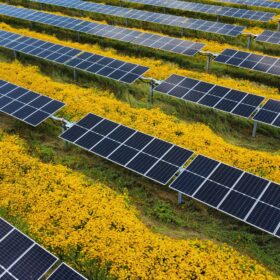In order to transition the bulk of our electricity systems away from conventional energy sources and to renewable energy and energy storage, a truly massive amount of capital will be needed. As such, financial innovation has always been a key need for the energy transition.
The investments that have been made to date, while not insignificant, are short of these needs, and one enduring problem has been the difficulty of attracting certain classes of investors to solar and wind, such as pension funds and insurance companies, which control massive amounts of capital but are highly risk-averse.
This week London-based Climate Policy Initiative (CPI), supported by the Rockefeller Foundation, released a design for a new investment vehicle to attract this “patient capital” to renewable energy. The Clean Energy Investment Trust (CEIT) would be an investment-grade vehicle to hedge long-term liabilities, while offering a higher return than bonds and requiring lower management fees than most asset managers.
“The CEIT mechanism breaks apart the traditional utility model of financing which is no longer fit for purpose in a high-renewables scenario,” states CPI Executive Director David Nelson. “By unbundling this model and splitting it into three distinct but interdependent cashflows, we can drive capital more efficiently towards a future energy system that is not only low-carbon, but also low-cost – that’s the prize.”
The non-profit says that the CEIT structure addresses many of the barriers that have prevented participation from such investors in the past, while avoiding some of the shortcomings of other vehicles such as yieldcos. As laid out in an accompanying report, CPI identifies barriers which include a lack of liquidity and difficulties in performing due diligence due to the lack of internal teams who could evaluate projects.
But perhaps more than anything, CPI found that asset managers have to date structured investment vehicles around their pre-existing business models, not models that work for institutional investors and would lower the cost of capital.
In particular, CPI distinguishes its CEIT from yieldcos. While both are publicly traded vehicles that hold solar and wind projects, the non-profit envisions its CEIT will not be able to buy or sell projects once the portfolio is set, sacrificing the growth premium that have made yieldcos popular for the risks around the availability, price and choice of new projects.
“Each of these risks is equivalent to the risks faced by an IPP or an IOU in the course of their business,” notes CPI in its report Mobilising low-cost institutional investment in renewable energy. “In other words, by adding the growth premium and risks, YieldCos begin to look more like the IOU or IPP equity they replace, rather than the bond-like characteristics that liability-hedging investors seek.”
The potential upside to attracting such institutional investment is huge. CPI says that due to barriers in 2016 only $305 billion of the $80 trillion in institutional investments was available, but says that this vehicle could allow $4 trillion in capital to be mobilized into the renewable energy sector. The non-profit also estimates that by lowering the cost of capital, it can reduce the cost of wind and solar projects by 15-17%.
This content is protected by copyright and may not be reused. If you want to cooperate with us and would like to reuse some of our content, please contact: editors@pv-magazine.com.









By submitting this form you agree to pv magazine using your data for the purposes of publishing your comment.
Your personal data will only be disclosed or otherwise transmitted to third parties for the purposes of spam filtering or if this is necessary for technical maintenance of the website. Any other transfer to third parties will not take place unless this is justified on the basis of applicable data protection regulations or if pv magazine is legally obliged to do so.
You may revoke this consent at any time with effect for the future, in which case your personal data will be deleted immediately. Otherwise, your data will be deleted if pv magazine has processed your request or the purpose of data storage is fulfilled.
Further information on data privacy can be found in our Data Protection Policy.